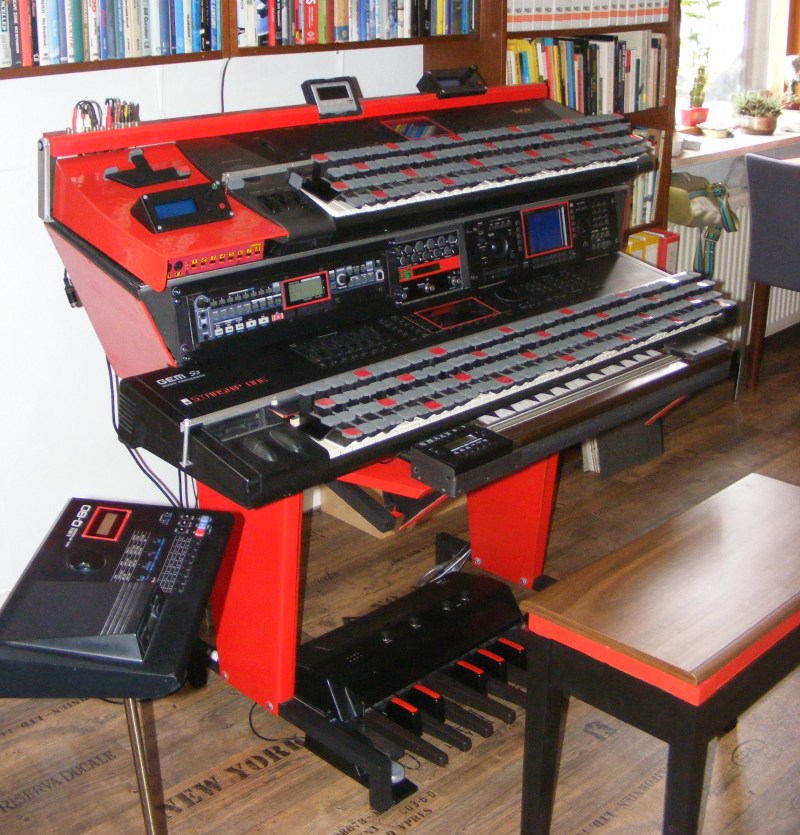We’ve seen some crazy music production stations over the years. But this synthesizer system may just take the cake. Starship One is the creation of [Marc Brasse]. At first glance, this music battle station looks like it belongs on the bridge of the Enterprise. The resemblance is not entirely unintentional. [Marc] himself says “Commander Data from Star Trek: The Next Generation might actually (have) like(d) it if he did not have such a conservative taste in music.”
At the core of Starship One are two underappreciated synths from the 90’s. The Technics WSA1, and a Gem S3 turbo. Both were keyboards ahead of their time. The WSA1 is a modeling synth, a sound generation trend in the ’90s which sounded great, but never quite caught on. The other strike against it was that it was built by Technics, who had a reputation for building HiFi equipment and home keyboards. Professionals just didn’t pick it up.
The Gem S3 had a similar story — built by a company called General Music, the keyboard was a great design with incredible piano action, but never quite made it. [Marc] wasn’t turned off by the lineage of these two synths. In fact, he embraced them. [Marc] explains more about his philosophy in creating the Starship One in this PDF document.
[Marc] combined these two instruments with Fatar MP1 bass pedals, a ribbon controller, and more additional components than we could ever hope to name here. The frame of the synth is built from a discarded retail CD sales rack. Extruded aluminum pieces came from a sun slat curtain. Just about every part was reused to build one beast of a workstation.
If you’re wondering what the strange keyboard layout is, it’s a Janko keyboard adapter [Marc] custom made. Instead of 88 notes, there are 264 keys, arranged so that every chord has the same fingering, regardless of the scale being played.
Want more modulation? Check out this ARM based FM synth, or this monster post of open source synths!
















Most important thing is the sound. Please add a link to a sample.
I think this album is all made on Starship One, according to its description…
http://www.brassee.com/electronicmusic.html#starships
The music is a reflection of the instrument, very creative and unique on many fronts. It’s not for those with a 5 second attention span or EDM fanatic, instead you will hear something that has been put together with highly contrasting elements, with the intention to challenge the listener with the sort of creativity that came from music concrete and other minimalistic elements that are all about expression vs. a 4/4 beat. Definitely worth a listen, if nothing else, as an introduction into those broader elements of musical expression that too few have been exposed to in our modern times – a sincere attempt that truly provides a refreshing contrast to tired ears.
Janko keyboards are so awesome. I’ve long wanted to have one. Didn’t think about making one, but this makes me wonder about it…
Marc Brasse and Jordan Rudess need to get together and talk shop. That’s all I’m saying.
Simply an awesome project.
However, Commander Data’s not so conservative:
https://www.youtube.com/watch?v=PiyZEbGSHnY
For music, perhaps. He’s a bit less sophisticated when it comes to theatre:
https://www.youtube.com/watch?v=UO8WiZab_PI
And his taste in the visual arts… lets just not go there.
https://www.youtube.com/watch?v=ngsqaRD2HI8
Haha. Even making a Vulcan cry with my music. Now that reduces all my endeavours to a central point alright. Although I’d obviosuly want him to cry in apreciation.
In the mean time:Thanks for al the kind comments. There still is hope for me yet.
Here here for the 6-6 keyboards, and Euler’s design.
Twelve is a neat number, but dividing it into 7 and 5 is weird. Same for notation where a base 7 system is divided by 2. No same note on same line all the time, and the lines vibrate in my vision. I have many junk keys from organs even the Hammond. I have been wanting to do this for too long.
Just in case you misunderstand. The red keys are only for general orientation. The red keys on the 1st and 3rd row from below actaully indicate C, the red keys on the 2nd and 4th row indicate F. So if you start on a red key on row 1 or 3 and then step over at the red key on row 3 or 4 you basically play the scale of C-sharp. I could have expanded that to a more normal Janko colouration but I simply want to know where I am within an octave and not as much relate to the all to abvous existing system. I actually tied it first with only poiting out the C’s but still tended to get my fingers crossed within octaves. Adding the F’s then seemed a good compromise. Now one can check the placement of his fingers in relation with these general indicators without thinking too much about the “official” scales in our 12 tone system.
Since people are asking, here’s where I describe making a Janko keyboard for the Moog Werkstatt a few months back. It uses capacitive touch sensor chips, so each key is just a thin sheet metal rectangle with a wire going to the sensor chip, and that made it a lot easier to make than a mechanical keyboard:
http://blog.freesideatlanta.org/2017/02/a-capacitive-touch-janko-keyboard-what.html
Very nice! The idea of combining existing mechanical technology with expanded expression is however a big part of what I am tryign to do here. Products like the Hakan Continuem go even further but this is also about not neccesarily discarding the best of the existing solution(s). Playing music is more then only triggering events and mechanical keyboards give a lot of tactile feedback. Pure trigger surfaces often lack such interaction.